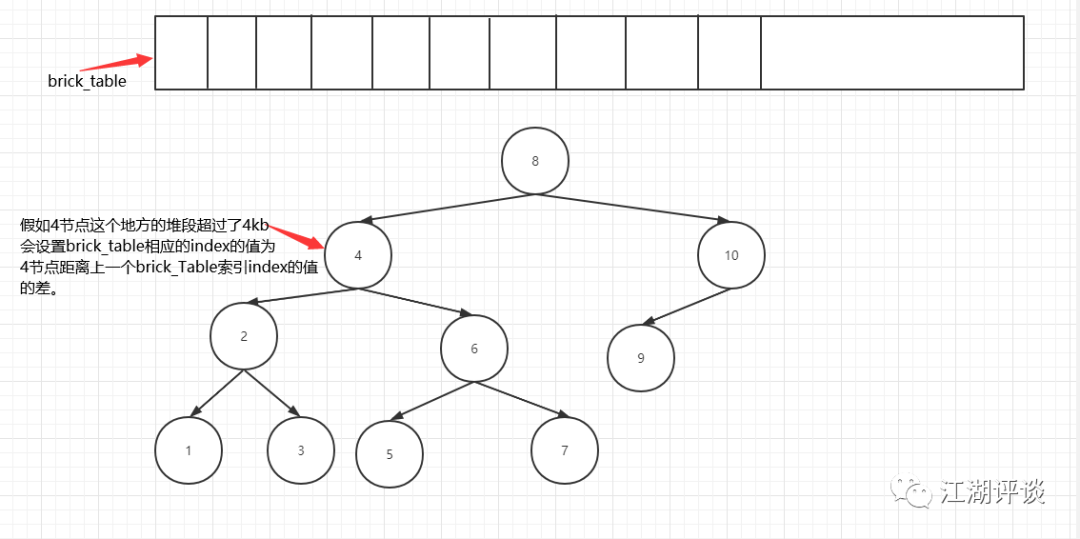楔子
Plan_Phase(GC的計劃階段)很早就接觸了,但是后面一直沒用到,忘記了,此次又用到了,幾乎忘光了,費了很大力氣理解它,記錄下,以免又忘記了。
主題
計劃階段(plan_phase)主要就兩個部分,一個是堆里面的對象構建一顆龐大的二叉樹。但是,這個二叉樹如果過于龐大,則成了性能瓶頸。于是乎,第二個部分Brick_table出現了,它主要是分割這個龐大的二叉樹,以消弭性能瓶頸問題。
構建不規則二叉樹
構建二叉樹之前,先了解一些概念。當實例化一個對象之后,這個對象存儲在堆里面。堆實際上是一長串的內存地址,不受CPU棧的管控,所以導致了它不能自動釋放,需要手動。在這一長串的地址里面,可以分為固定對象和非固定對象。
1.固定對象概念
首先看下固定句柄,固定句柄就是把托管對象傳遞到費托管對象的堆棧里面去,固定句柄本身在托管里面進行管理,而它包含的對象就叫做固定對象。
至于非固定對象,就是普通的對象了,此處不再贅述。
在進行GC計劃階段的時候,會循環遍歷當前需要收集的垃圾的代(generation)里面包含的所有堆,然后區分出包含固定對象的堆段,和非固定對象的堆段。
區分規則是怎么樣的呢?非常簡單,具體的就是如果相鄰的兩個對象都是非固定對象或者都是固定對象,則把這兩個對象作為一個堆段,繼續查找后面的對象。如果后續的對象跟前面的對象相同,則跟前面的兩個對象放在一起形成一個堆段(如果后面還有相同的,則繼續放在一起),如果不同,則此堆段到此為止。后面繼續以同樣的邏輯遍歷,形成一個個的小堆段(以node表述)。
2.這里有一個特性:
固定堆段(也就是固定對象組成的堆段)的末尾必須跟一個非固定對象(這么做的原因,是避免固定對象的末尾被覆蓋,只覆蓋非固定對象的末尾)。
二叉樹的構建,就建立在這些固定對象堆段和非固定對象堆段上的。這些一個個的堆段作為二叉樹的根節點和葉子結點,構成了二叉樹的本身。
3.相關構建
一:plug_and_pair結構
plug_and_pair存在于上面被分割的堆段的前面,堆段以node(節點)表示,則此結構(plug_and_pair*)node)[-1]的位置
struct plug
{uint8_t * skew[plug_skew / sizeof(uint8_t *)];
};class pair
{public:short left;short right;
};
struct plug_and_pair
{pair m_pair;plug m_plug;
};pair的left和right成員分別表示當前堆段距離其前一個堆段和后一個堆段的距離長度。
二:構建邏輯
構建邏輯分為三種,數字一般可以分為奇數和偶數。計算機也是一樣,但是除了這兩種之外,偶數里面還可以分裂出另外一種情況,就是一個數字是2的次方數。舉個例子,比如:1,2,3,4,5,6,7,8,9,10。這十個數字里面,明顯的奇數:1,3,5,7,9。偶數:2,4,6,8,10。再分裂下二的次方數:2,4,8。注意看,最后分裂的結果2,4,8分別是2的1次方,2次方和3次方。剔除了6和10這兩個數字。
那么總結下,三種邏輯以上面試個數字舉例分別為:
遍歷循環以上十個數字。
第一種(if(true)):1,2,4,8 if(!(n&(n-1))) n分別為2,4,8。if里為true
第二種(if(true)):3,5,7,9 if(n&1) n分別為1,3,5,7,9。if里為true
第三種(if(true)):6,10 如果以上兩種不成立,則到第三種這里來。
三:構建樹身
如上所述,通過對堆里面的對象進行固定和非固定對象區分,變成一個個的小堆段(node)。這些小堆段從左至右依次編號:1,2,3,4,5,6,7,8,9.......N。然后通過構建邏輯這部分進入到if里面去。
1.(if(true)):
1,2,4,8編號的node會進入這里,主要是設置左節點和tree
set_node_left_child (new_node, (tree - new_node));tree = new_node;2.(if(true)):
3,5,7,9編號的node會進入這里,主要是設置右節點
set_node_right_child (last_node, (new_node - last_node));3.(if(true)):
6,10編號的會進入這里,主要是把原來的二叉樹的右子節點變成新的node(new_node)的左子節點,切斷二叉樹與它自己右子節點的聯系。然后把新的node(new_node),變成原來二叉樹的右子節點。uint8_t* earlier_node = tree;size_t imax = logcount(sequence_number) - 2;//這里是獲取需要變成的二叉樹的右子樹節點的層級。for (size_t i = 0; i != imax; i++)//如果層級不等于0,則獲取到二叉樹根節點到右子節點的距離,然后把根節點與右子節點相加得到二叉樹右子節點。如此循環遍歷,到二叉樹最底層的右子節點為止。{earlier_node = earlier_node + node_right_child (earlier_node);}獲取到最后一顆二叉樹的根節點的右子樹的距離int tmp_offset = node_right_child (earlier_node);assert (tmp_offset); // should never be empty把最后一顆二叉樹的根節點和最后一顆二叉樹的右子節點相加,設置為新的node(new_node)的左子樹。set_node_left_child (new_node, ((earlier_node + tmp_offset ) - new_node));把最后一顆二叉樹的右子樹節點設置為新的node(new_node)節點,同時也是斷了開與原來右子樹的聯系。set_node_right_child (earlier_node, (new_node - earlier_node));GC plan_phase的二叉樹構建本身并不復雜,而是復雜的邏輯和詭異的思維方式。
最終的構建的二叉樹形式如下圖所示:
四.分割二叉樹
當以上二叉樹被構建之后,如有幾千個節點(node,小堆段)會形成龐大的一棵樹。所以需要分割功能,用以來保證性能。
當二叉樹包含的小堆段(node)的長度超過2的12次方(4kb),這棵二叉樹就會被分割。

Brick_table里面屬于這個4節點范圍內的都是賦值為-1,表示你要在4節點上尋找你需要的節點。
源碼:
最后上一下源碼
1.構建二叉樹:
uint8_t* gc_heap::insert_node (uint8_t* new_node, size_t sequence_number,uint8_t* tree, uint8_t* last_node)
{dprintf (3, ("IN: %Ix(%Ix), T: %Ix(%Ix), L: %Ix(%Ix) [%Ix]",(size_t)new_node, brick_of(new_node),(size_t)tree, brick_of(tree),(size_t)last_node, brick_of(last_node),sequence_number));if (power_of_two_p (sequence_number)){set_node_left_child (new_node, (tree - new_node));dprintf (3, ("NT: %Ix, LC->%Ix", (size_t)new_node, (tree - new_node)));tree = new_node;}else{if (oddp (sequence_number)){set_node_right_child (last_node, (new_node - last_node));dprintf (3, ("%Ix RC->%Ix", last_node, (new_node - last_node)));}else{uint8_t* earlier_node = tree;size_t imax = logcount(sequence_number) - 2;for (size_t i = 0; i != imax; i++){earlier_node = earlier_node + node_right_child (earlier_node);}int tmp_offset = node_right_child (earlier_node);assert (tmp_offset); // should never be emptyset_node_left_child (new_node, ((earlier_node + tmp_offset ) - new_node));set_node_right_child (earlier_node, (new_node - earlier_node));dprintf (3, ("%Ix LC->%Ix, %Ix RC->%Ix",new_node, ((earlier_node + tmp_offset ) - new_node),earlier_node, (new_node - earlier_node)));}}return tree;
}2.切割二叉樹:
size_t gc_heap::update_brick_table (uint8_t* tree, size_t current_brick,uint8_t* x, uint8_t* plug_end)
{dprintf (3, ("tree: %Ix, current b: %Ix, x: %Ix, plug_end: %Ix",tree, current_brick, x, plug_end));if (tree != NULL){dprintf (3, ("b- %Ix->%Ix pointing to tree %Ix",current_brick, (size_t)(tree - brick_address (current_brick)), tree));set_brick (current_brick, (tree - brick_address (current_brick)));//brick_table索引處的值是:根節點tree距離當前current_brick對應的地址的距離}else{dprintf (3, ("b- %Ix->-1", current_brick));set_brick (current_brick, -1);}size_t b = 1 + current_brick;ptrdiff_t offset = 0;size_t last_br = brick_of (plug_end-1);//上一個plug節點的末尾current_brick = brick_of (x-1);//當前的plug_startdprintf (3, ("ubt: %Ix->%Ix]->%Ix]", b, last_br, current_brick));while (b <= current_brick){if (b <= last_br){set_brick (b, --offset);}else{set_brick (b,-1);}b++;}return brick_of (x);
}以上參考:
https://github.com/dotnet/coreclr/blob/main/src/gc/gc.cpp

















)

